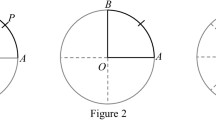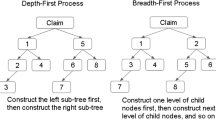Abstract
Although many studies have shown that diagrams are effective tools for problem solving, research evidence shows that students do not always use diagrams effectively. One of the most serious problems is their lack of spontaneity in diagram use. However, no previous studies have examined whether teachers are adequately aware of this problem. In this investigation, data were gathered on students’ mathematics performance (including their spontaneous use of diagrams) and teachers’ predictions of the students’ performance. Using a mathematical model (Uesaka & Nakagawa, 2010) to analyze the data, it was found that the parameter representing the accuracy of teachers’ prediction was lower for their assessment of spontaneous diagram use compared to other mathematical tasks. This suggests that spontaneity in diagram use is an overlooked aspect in teachers’ view of student performance.
Access this chapter
Tax calculation will be finalised at checkout
Purchases are for personal use only
Similar content being viewed by others
References
Cheng, P.C.H.: Electrifying Diagrams for Learning: Principles for Complex Representational Systems. Cognitive Science 26, 685–736 (2002)
Uesaka, Y., Manalo, E., Ichikawa, S.: What Kinds of Perceptions and Daily Learning Behaviors Promote Students’ Use of Diagrams in Mathematics Problem Solving? Learning and Instruction 17, 322–335 (2007)
Uesaka, Y., Suzuki, M., Kiyokawa, S., Seo, M., Ichikawa, S.: Using COMPASS (Componential Assessment) to Reveal Japanese Students’ Actual Competence in the Fundamentals of Mathematics: Is it True that “Students are Generally Fine with the Fundamentals, and that the Problems Exist Only in Applications”? (submitted)
Ichikawa, S., Haebara, T., Sugisawa, T., Seo, M., Kiyokawa, S., Inuzuka, M., Murayama, K., Uesaka, Y., Kobayashi, H., Shinogaya, K.: Development of COMPASS: Componential Assessment for Basic Competence and Study Skills in Mathematics. Cognitive Studies 16(3), 333–347 (2009)
Uesaka, Y., Nakagawa, M.: Development and Application of Mathematical Model Analyzing Teachers’ Accuracy of Predication of Students’ Performance: Proposing Empirical Methods Detecting Overlooked Competences and Learning Skills. In: Paper in Proceedings of the Annual Conference of the Japanese Cognitive Science Society, pp. 350–356 (2010)
Author information
Authors and Affiliations
Editor information
Editors and Affiliations
Rights and permissions
Copyright information
© 2012 Springer-Verlag Berlin Heidelberg
About this paper
Cite this paper
Uesaka, Y., Manalo, E., Nakagawa, M. (2012). Are Teachers Aware of Students’ Lack of Spontaneity in Diagram Use? Suggestions from a Mathematical Model-Based Analysis of Teachers’ Predictions. In: Cox, P., Plimmer, B., Rodgers, P. (eds) Diagrammatic Representation and Inference. Diagrams 2012. Lecture Notes in Computer Science(), vol 7352. Springer, Berlin, Heidelberg. https://doi.org/10.1007/978-3-642-31223-6_36
Download citation
DOI: https://doi.org/10.1007/978-3-642-31223-6_36
Publisher Name: Springer, Berlin, Heidelberg
Print ISBN: 978-3-642-31222-9
Online ISBN: 978-3-642-31223-6
eBook Packages: Computer ScienceComputer Science (R0)




